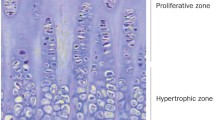Abstract
Many systemic diseases impair linear growth. If remission occurs, growth will often accelerate beyond the normal rate for age, a phenomenon termed ”catch-up growth.” As a result, final height is improved, although this recovery of adult stature is frequently incomplete. Two principal models have been proposed to explain catch-up growth. The first model postulates a central nervous system mechanism that compares actual body size with an age-appropriate set-point and then adjusts growth rate accordingly. However, there is recent evidence that growth inhibition in a single growth plate is followed by local catch-up growth, a finding not readily explained by the neuroendocrine model. Thus, a new model has been proposed that places the mechanism within the growth plate itself. According to this model, growth-inhibiting conditions decrease proliferation of growth plate stem cells, thus conserving their proliferative potential. Additional research is needed to determine whether the mechanisms governing catch-up growth are local, systemic, or both.
Similar content being viewed by others
Author information
Authors and Affiliations
Additional information
Received: 5 March 1999 / Revised: 16 December 1999 / Accepted: 23 December 1999
Rights and permissions
About this article
Cite this article
Gafni, R., Baron, J. Catch-up growth: possible mechanisms. Pediatr Nephrol 14, 616–619 (2000). https://doi.org/10.1007/s004670000338
Issue Date:
DOI: https://doi.org/10.1007/s004670000338




